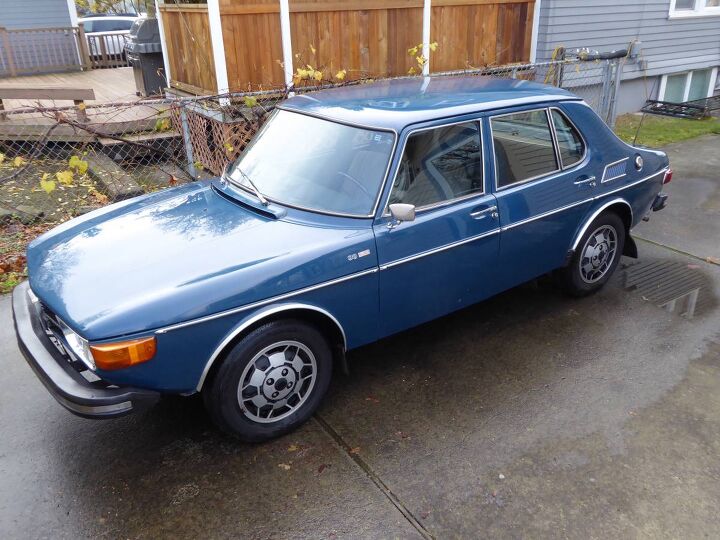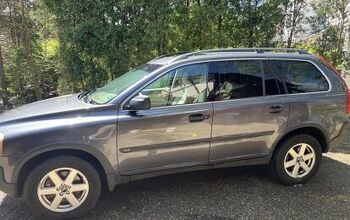Rare Rides: A Tiny and Stylish Saab 99 From 1973

Saab was always a fan of the number nine, and it proved its dedication to the special digit by using two nines for their pre-900 era compact executive car.
Let’s take a look at a little blue Saab 99.
In the early Sixties, executives at Saab headquarters were desirous of a larger car to extend the brand’s appeal beyond the very small 96 model. Project approval secured, the so-called Gudmund vehicle was underway.
Engineers started by chopping up an existing 96. They cut it down the middle and added nearly eight inches to its width. The resulting prototype was called the Toad, and it was built for deception. Saab intended to work on the Gudmund underneath the shell of the Toad, maintaining secrecy as the new model was developed on the roads of Sweden. The little game worked for a while, until observers noted the unusual grey wide-track 96 being tailed by a regular-width 96.
The Toad allowed for testing of the chassis and other mechanical components of the new Saab while the body shell was under development. Not content with using the two-stroke engine from the 96 for this upscale model, company engineers set their sights abroad. Eventually they settled on a 1.7-liter four-cylinder Triumph engine — the same one used in the Dolomite. The company attached their own carburetor and paired it to a three-speed manual transmission for the first examples.
Once ready, the prototype vehicle — now known as the 99 — was badged as a Daihatsu on Swedish roads, since the individual letters of the brand could be sourced from existing Saab model badging. By November of 1967 the 99 was ready for its Stockholm debut. The first examples (all two-door sedans or three-door liftbacks) went on sale in fall of 1968. The four-door 99 arrived in 1970, which coincided with some visual editing, a nicer interior, and the availability of a three-speed automatic.
Changes occurred every year for the 99, varying by continent because of European and North American legislation. Evolution turned to revolution in 1978, as Saab paved the way for decades of future models with the introduction of the 99 Turbo.
The 99 was a success, and, when the long-lived model ended production in 1984, over 588,000 had been produced. However, the essence of the 99 would live on for another two decades, as it formed the basis for the 900 model built from 1978 to 1993.
Today’s tidy 99 comes to us from the rust-free area of Portland, where the dream of the Nineties is still alive. By the ’73 model year (and per the badge), Saab increased the 99’s engine to 2.0 liters of displacement via their own redesign of the original Triumph 1.7. With a substantial 195,000 miles under its belt, this preserved Swede asks $6,200.
[Images: seller]

Interested in lots of cars and their various historical contexts. Started writing articles for TTAC in late 2016, when my first posts were QOTDs. From there I started a few new series like Rare Rides, Buy/Drive/Burn, Abandoned History, and most recently Rare Rides Icons. Operating from a home base in Cincinnati, Ohio, a relative auto journalist dead zone. Many of my articles are prompted by something I'll see on social media that sparks my interest and causes me to research. Finding articles and information from the early days of the internet and beyond that covers the little details lost to time: trim packages, color and wheel choices, interior fabrics. Beyond those, I'm fascinated by automotive industry experiments, both failures and successes. Lately I've taken an interest in AI, and generating "what if" type images for car models long dead. Reincarnating a modern Toyota Paseo, Lincoln Mark IX, or Isuzu Trooper through a text prompt is fun. Fun to post them on Twitter too, and watch people overreact. To that end, the social media I use most is Twitter, @CoreyLewis86. I also contribute pieces for Forbes Wheels and Forbes Home.
More by Corey Lewis
Latest Car Reviews
Read moreLatest Product Reviews
Read moreRecent Comments
- ToolGuy I might be Batman.
- Lou_BC Well, I'd be impressed if this was in a ZR2. LOL
- Lou_BC This is my shocked face 😲 Hope formatting doesn't fook this up LOL
- Lou_BC Junior? Would that be a Beta Romeo?
- Lou_BC Gotta fix that formatting problem. What a pile of bullsh!t. Are longer posts costing TTAC money? FOOK









































Comments
Join the conversation
I'd still love to have a Saab 99EMS
This vintage of Saabs are the Birkenstock of cars.